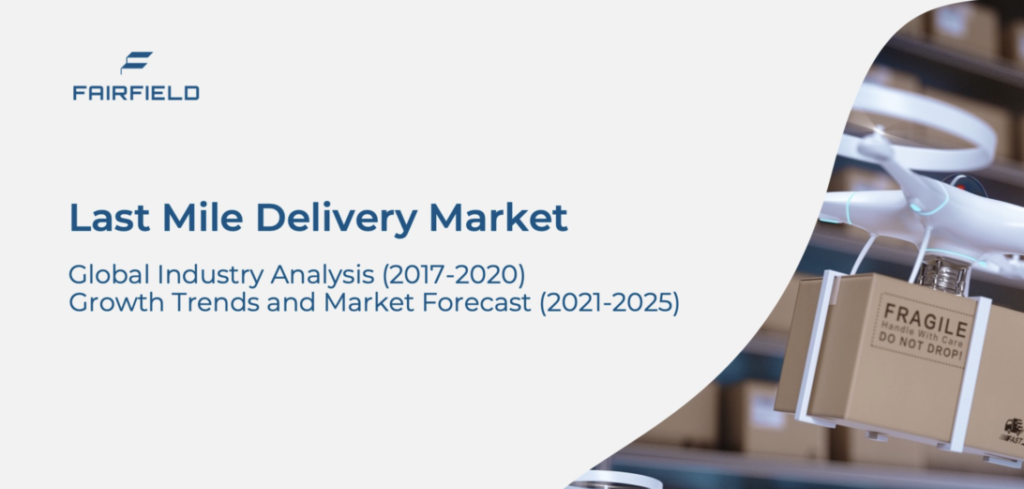The birth of e-commerce has boosted the demand for last-mile delivery services globally. Based on the premise of delivering packages to customers in the shortest timespan, the last-mile delivery market is looking at an excellent growth rate. According to Fairfield Market Research, the global last-mile delivery market is expected to surge at a CAGR of 16% between the forecast years of 2021 and 2025. Growing internet access and avenues for online shopping are expected to give the last-mile delivery market exponential opportunities in the forecast period.
Retailers will make heavy investments in last-mile delivery services to create an easy shopping experience
Retailers utilize last-mile delivery as a key to staying ahead of the competition. In 2018, Amazon took 41% of the US retail market share with its Amazon Prime same- and next-day delivery services. Analysts predict that numerous e-commerce players are investing in their last-mile delivery services to appeal to a wider consumer base. Investments include route optimization, auto-dispatch, bird’s eye view, proof of delivery, real-time status update, real-time visibility, audit key metrics, and analytics to allow easy tracking to the end customer, creating a more transparent shopping experience.
The introduction and application of sensors, delivery by drones/self-driving cars/robots and city warehousing are expected to be among the upcoming trends in the global last-mile delivery market. These technological advancements will accelerate the market’s growth by boosting investors’ confidence.
Vulnerability of FMCG goods will create dependence on last-mile delivery services
The fast-moving consumer goods (FMCG) segment will emerge as the key user of last-mile delivery services as its products remain highly susceptible to spoilage within a short timespan. Furthermore, e-commerce has created considerable demand for seamless last-mile delivery services for such goods. Increasing numbers of consumers are adopting the trend of online shopping or e-retail. The global pandemic has accelerated the need to shop online while staying home, which has further strengthened the demand for the FMCG sector. This sector will be highly influenced by technological developments such as real-time monitoring, shopping assistants and no-contact delivery in light of the Covid-19 pandemic. Companies such as Wing Aviation, Kiwi Campus and Boxbot are partnering with numerous food outlets and local restaurants to facilitate delivery in the UK, USA and Australia.
Wide acceptance of e-commerce will boost market growth in North America
North America is expected to lead the global market as the region sees continuous development in autonomous delivery robot mechanisms. E-commerce has wide acceptance in this region as consumers are opting for quick delivery and increased e-retail transactions. Additionally, numerous retailers are providing free returns and exchanges, which is expected to further accelerate the demand for reverse logistics in the last-mile delivery model.
Competition is expected to increase in Asia-Pacific as this region has increasing numbers of exports and imports due to developing economies such as China and India. This region is a hub for major industries and car manufacturers, bolstering demand for the last-mile delivery market. Furthermore, a younger population base with adequate disposable income has been fueling this market by embracing the online shopping culture.
Key players are extending their services and consumer base to stay ahead of the competition
The global last-mile delivery market is highly fragmented. Key players are increasingly adopting numerous strategies such as mergers and acquisitions, collaboration and joint ventures to stay ahead of the competition.
FedEx Express opened a new ramp operation facility at Luis Muñoz Marin International Airport in Carolina, Puerto Rico in 2019. This new facility is part of the company’s strategy to accelerate operational efficiency and cater to the needs of a growing consumer base. In 2018, XPO Logistics in Europe extended its last-mile logistics service, including services for heavy goods. It focused on France, the Netherlands, Spain and the US. The company is expected to achieve more than 750,000 last-mile deliveries from retailers and e-commerce in Europe.
For more information on the key players and developments in the last-mile delivery market, visit https://www.fairfieldmarketresearch.com/report/last-mile-delivery-market/
About the author:
Chetan Kudale is a lead domain consultant for the automotive and transportation domain at Fairfield Market Research.


